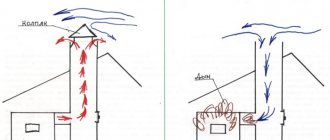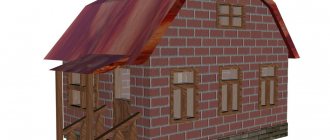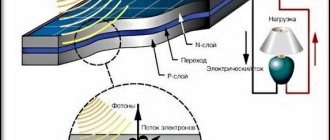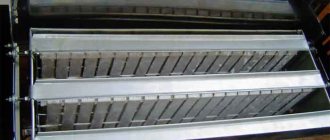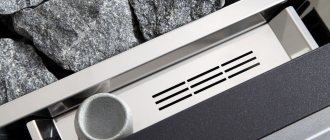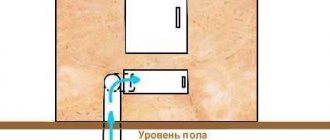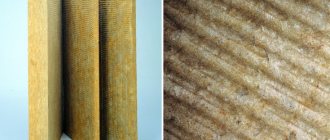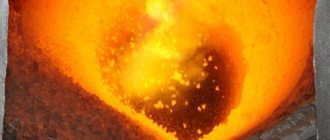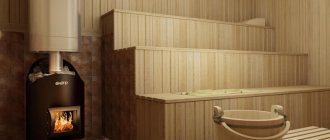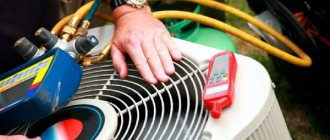A short excursion into the physics of the phenomenon
The dew point is the temperature of the air at which excess moisture contained in it falls out in the form of condensation. Why is there too much of it? The fact is that warm air holds a large amount of water vapor, cold air holds much less. It is this temperature difference that forms condensation . An example of the phenomenon are drops of water on cold water pipes or windows, or fog.
What else you need to know about dew point:
- The higher the humidity, the closer it is to the air temperature, and vice versa.
- Its value cannot be higher than the air temperature.
- Condensation always appears on cold surfaces . This is explained by the fact that the warm air next to them cools and its humidity decreases.
The unit of measurement for the condensation point is degrees Celsius.
Quantification of humidity.
In order to quantify air humidity, they use, in particular, the concepts of absolute and relative .
Absolute humidity is the number of grams of water vapor contained in 1 3m of air under given conditions, i.e. it is the density of water vapor ρ, expressed in g/m3.
Relative air humidity φ is the ratio of absolute air humidity ρ to ρ0 density of saturated vapor at the same temperature. Relative humidity is expressed as a percentage:
.Vapor concentration is related to pressure (p0 = nkT), so relative humidity can be defined as the percentage ratio of the partial pressure p of vapor in air to the pressure p0 of saturated vapor at the same temperature:
Partial pressure to the pressure of water vapor that it would produce if all other gases were absent in the atmospheric air.
If moist air is cooled, then at a certain temperature the steam in it can be brought to saturation. With further cooling, water vapor will begin to condense in the form of dew.
How does dew behave on uninsulated walls?
With uninsulated walls, there are several variations in the behavior of the dew point. In some situations, it is located in the inner space of the wall - closer to the street or closer to the room. In the second case, with a strong decrease in temperature, the place of steam condensation will shift to the inner surface of the wall. Then drops of condensation will certainly form on its surface.
In some cases (cold building frame material), the dew point can be located indoors all year round, that is, on the inner surface of the wall. Then it is necessary to make applied calculations and take care of the insulation of the wall, taking into account the climatic characteristics of the locality in which the building is located.
In general, the location of the dew point in a ceiling or wall is interconnected with a number of physical factors:
- humidity of outdoor air and indoor air;
- outdoor and indoor air temperatures;
- thickness of the ceiling or wall.
What is dew point
The dew point is the temperature to which the air must cool for the water vapor it contains to reach a state of saturation and begin to condense into dew. Simply put, this is the temperature at which condensation occurs.
The dew point temperature is determined by only two parameters: temperature and relative humidity. The higher the relative humidity, the higher the dew point and the closer to the actual air temperature. The lower the relative humidity, the lower the dew point than the actual temperature.
The concept of dew point
The dew point is the temperature at which precipitation or condensation of moisture occurs from the air, which was previously in a vapor state. In other words, the dew point in construction is the boundary of transition from the low air temperature outside the enclosing structures to the warm temperature of the internal heated rooms, where moisture may appear; its location depends on the materials used, their thickness and characteristics, the location of the insulating layer and its properties.
Dew point in a wall without insulation
The regulatory document SP 23-101-2004 “Design of thermal protection of buildings” and SNiP 23-02 “Thermal protection of buildings” regulate the conditions relating to the accounting and value of the dew point:
“6.2 SNiP 23-02 establishes three mandatory mutually related standardized indicators for the thermal protection of a building, based on:
“a” – standardized values of heat transfer resistance for individual building envelopes for thermal protection of the building;
“b” – standardized values of the temperature difference between the temperatures of the internal air and on the surface of the enclosing structure and the temperature on the inner surface of the enclosing structure above the dew point temperature;
“c” – a standardized specific indicator of thermal energy consumption for heating, which allows one to vary the values of the heat-protective properties of enclosing structures, taking into account the choice of systems for maintaining standardized microclimate parameters.
The requirements of SNiP 23-02 will be met if the requirements of indicators of groups “a” and “b” or “b” and “c” are met when designing residential and public buildings.
Condensation of water vapor most easily occurs on some surface, but moisture can also appear inside the thickness of structures. With regard to wall construction: in the case where the dew point is located close to or directly on the inner surface, under certain temperature conditions during the cold season, condensation will inevitably form on the surfaces. If the enclosing structures are not sufficiently insulated or are constructed without installing an additional insulating layer at all, then the dew point will always be located closer to the internal surfaces of the premises.
The appearance of moisture on the surfaces of structures is fraught with unpleasant consequences - this creates a favorable environment for the proliferation of microorganisms, such as fungus and mold, the spores of which are always present in the air. In order to avoid these negative phenomena, it is necessary to correctly calculate the thickness of all elements that make up the enclosing structures, including calculating the dew point.
According to the instructions of the regulatory document SP 23-101-2004 “Design of thermal protection of buildings”:
“5.2.3 Temperature of the internal surfaces of the external fences of the building, where there are heat-conducting inclusions (diaphragms, through inclusions of cement-sand mortar or concrete, interpanel joints, rigid connections and flexible connections in multilayer panels, window frames, etc.), in the corners and on window slopes should not be lower than the dew point temperature of the air inside the building...”
If the temperature of the surface of the wall indoors or window units is lower than the calculated dew point value, then condensation is likely to appear in the cold season, when the outside air temperature drops to negative values.
Solving the problem - how to find the dew point, its physical value, is one of the criteria for ensuring the required protection of buildings from heat loss and maintaining normal microclimate parameters in the premises, in accordance with the conditions of SNiP and sanitary and hygienic standards.
The nature of the appearance of dew
Water condensation on various surfaces occurs as follows. Atmospheric air is always saturated with water vapor to one degree or another. Water changes from a gaseous state to a liquid state when its temperature decreases. This occurs when atmospheric air comes into contact with colder surfaces and subsequent heat loss. The result is the appearance of water droplets.
Morning dew is easily explained by the laws of physics
The temperature at which water vapor from the air passes into a liquid state is called dew point .
The higher the content of water vapor in the air (or other mixture of gases), the higher the condensation temperature of water, or dew point. So, with a relative air humidity of 100%, the dew point exactly coincides with its temperature. And vice versa: the lower the relative air humidity, the lower the dew point. This means that for condensation to fall out, you will have to cool the air more.
Studying the dew point in construction
The term "dew point" in construction
The constantly growing and developing market for construction products presents a wide selection of materials for thermal insulation. The choice of thermal insulation for industrial and residential premises must be approached properly and during construction, pay attention to the indicator in question.
Due to incorrect measurement of the dew point, fogging of walls often occurs, mold appears, and sometimes destruction of structures
Experts consider the boundary of transition from low temperatures outside the walls to higher temperatures inside heated structures with the possible formation of condensation to be the dew point. Drops of water will appear on any surface in the room whose temperature is close to the dew point parameter or reaches a value lower. The simplest example: in the middle of some rooms, condensation flows onto the window panes during cold times.
The main factors influencing the determination of the value are:
- climatic factors (temperature and air humidity outside);
- temperature values inside;
- indoor humidity indicator;
- wall thickness;
- vapor permeability of thermal insulation used in construction;
- availability of heating and ventilation systems;
- purpose of structures.
Correct determination of dew point is of utmost importance in construction
Only if the indicator is measured correctly can the building be used comfortably in the future and will reduce maintenance costs in the future.
Dew point calculation
Many owners of square meters are interested in the question of how to independently calculate the dew point in the wall. Purely theoretically, there is nothing difficult about this, especially if you are a mathematician, physicist, or simply remember the school curriculum well.
To do this you need to use the formula:
TP = (b * λ(T,RH)) / (a * λ(T,RH)), where:
- TP – desired point;
- a is a constant equal to the value 17.27;
- b – constant equal to the value 237.7;
- λ(Т,RH) – coefficient, which is calculated as follows:
λ(T,RH) = (a*T) / (b*T+ lnRH), where:
- T – internal room temperature;
- RH – indoor humidity, the value is taken in fractions, not percentages: from 0.01 to 1;
- ln – natural logarithm.
If in school you were more interested in playing basketball or reading Dostoevsky than logarithms, don't worry. Everything has already been calculated in the thermal protection data table under the number SP 23-101-2004, compiled on the basis of measurements and calculations by research and design organizations.
The most likely values under average Russian conditions are shown in the table below:
If you decide to calculate the value, you will get data similar to what is shown in the table. Among other things, you can use an online calculator to calculate.
Dew point in the wall of a house - why it is important to know it
Most of the year there is a significant difference between the temperature and humidity conditions outside and indoors. That is why areas of condensation often appear in the thickness of walls with insulation. When weather conditions change, they move closer to the outer or inner surface of the wall . That is, to a colder or warmer area.
Example: air temperature is stable at 25°C and humidity at 45%. In this case, condensation forms in an area with a temperature of 12.2°C. When humidity increases to 65%, the dew point shifts to a warmer area, where 18°C.
Why is it so important to know the location of the condensation point? Because it determines which layer of the wall “pie” is exposed to the destructive effects of moisture. The worst option is when the insulation gets wet. Under such conditions, most thermal insulation materials lose their properties. They become deformed, allow cold air to pass through , rot, and lose their elasticity. Mineral wool is especially susceptible to these processes.
How to move the dew point in a wall
If after all the calculations you are not satisfied with the location of the dew point, you should think about shifting it. To do this you can:
- increase the layer of insulation on the outside;
- use material with high vapor permeability;
- dismantle the layer of internal insulation, moving it outside;
- adjust the microclimate in the room - install forced ventilation, additionally heat the air.
The appropriate option is chosen based on the climatic conditions of the region of residence, the design features of the house, financial capabilities and the building materials used.
Ignoring such a phenomenon as moisture condensation in the wall “pie” can be very expensive. At a minimum, this is an unpleasant smell in the room, constant dampness . At the most, there are large colonies of mold fungi that spoil the interior decoration of the walls, destroy the insulation and harm the health of household members. Therefore, calculating the dew point is essential if you want to build safe and dry walls for your home.
Bookmark Permanent link. Did you like the article? Share: Rate: Average score: 4.49 Ratings: 53 Loading…
Load new article...—-
- Where to begin
- DIY construction
- Projects and drawings
- Varieties
- Tools and materials
- Foundation
- The most useful Frame houses - an introduction to the technology Photos of frame houses 9 options for the exterior finishing of a frame house House kit for a frame house Programs for designing frame houses
- Recent publications
- Methods for forming and covering warm corners in a frame house
- Frame houses from
- How to calculate a beam online using a calculator - operating principle and important points
- How to lift a frame house for renovation and move it to a new location
Frame structure and instructions for building a frame cabin with your own hands
Comfortable dew point values for humans
Dew point, °CHuman perceptionRelative humidity (at 32°C), %
| more than 26 | extremely high perception, deadly for asthma patients | 65 and above |
| 24-26 | extremely uncomfortable condition | 62 |
| 21-23 | very humid and uncomfortable | 52-60 |
| 18-20 | unpleasant for most people | 44-52 |
| 16-17 | comfortable for most, but feels at the upper limit of humidity | 37-46 |
| 13-15 | comfortable | 38-41 |
| 10-12 | very comfortable | 31-37 |
| less than 10 | a little dry for some | 30 |
A few facts about dew point.
- The dew point temperature cannot be higher than the current temperature.
- The higher the dew point temperature, the more moisture there is in the air
- High dew point temperatures occur in the tropics, low in deserts and polar regions.
- Relative humidity (RH) of about 100% leads to dew, frost (frozen dew), and fog.
- Relative humidity (RH) reaches 100% during the rainy season.
- High dew points usually occur ahead of cold temperature fronts.
Damage to dew point for house walls
We figured out that the dew point can be located in three different parts of the wall:
- in external wall insulation
- in the wall, closer to the outside
- in the wall, closer to the inside
In each of the listed places, the dew point will manifest itself differently. If in one place it is harmless, then inside the house or in the wall it will have certain destructive consequences on the integrity of the wall. Below, we will analyze the behavior of the dew point in each of the listed places.
Dew point in external insulation
This is the most harmless dew point for your home. In this case:
- When the dew point occurs, condensation forms directly in the insulation itself.
- The insulation is not hygroscopic, therefore moisture is not retained in the wall structure and evaporates when the air temperature changes.
- Due to the vapor barrier properties of the insulation, the moisture that is formed when condensation evaporates goes outside and does not interact with the wall of the house.
- The walls of the house are dry throughout the year, both from the outside and from the inside
- The walls retain their strength and integrity for many decades
insulation on the outside
Dew point in the wall of the house, closer to the outside
- The behavior of a wall largely depends on the material from which it is made. Walls made of dense and heavy building materials such as brick, expanded clay concrete, stone, and wood can withstand dew point better. Because they are less susceptible to destruction and have a higher frost resistance coefficient.
- The walls of houses built from porous materials that absorb moisture well and allow steam to pass through. Such as foam blocks, gas blocks and similar materials, the effect of the dew point should be minimally short.
destruction of a wall due to moisture
- When condensation occurs inside the wall, the wall material becomes saturated with liquid. When the air temperature subsequently drops below zero, the accumulated liquid freezes and increases in volume. An increase in the volume of liquid destroys any wall material from the inside. This leads to the formation of both small and large cracks in the wall structure. The walls crumble and finally lose their strength.
- If the wall, in which the dew point is inside and is insulated from the outside, then the insulation will not prevent the accumulated moisture from escaping outside. Therefore, all the liquid will accumulate on the surface, between the insulation and the wall. This entails the formation of mold and mildew, with all the ensuing consequences that are harmful both to the building and to human health.
- If the wall of the house is not insulated from the outside, then the liquid will come out as the air temperature rises, but this will not protect the wall from internal destruction after the water freezes. We can observe similar evaporation of liquid from a damp wall in the form of a white coating on brick walls.
release of moisture from a brick wall in the form of a white coating
Dew point in the wall of the house, closer to the inner surface
It occurs when steam passes through the middle of the wall thickness and condensation begins to form closer to the surface of the wall, which is located inside the house.
Consequences of dew point for the interior decoration of the house:
- The masonry, saturated with moisture, begins to release liquid in the form of water droplets on the inner wall and into the house.
- A wet wall surface destroys the interior decoration of the room: putty, wallpaper and other finishing materials.
- Mold and mildew form on the walls and in the corners, which will be very difficult to get rid of.
- An unpleasant, shabby smell of decomposition appears in the house, which is harmful to health.
- The overall heat temperature in the house decreases.
mold on the wall inside the house
The most destructive and harmful consequences for the house is when the dew point is closer to the inner surface of the wall.
Dew point is an important parameter that should be taken into account when designing and constructing walls, roofs and the construction of the entire house. Failure to comply with it can lead to irreversible and critical consequences for the entire building.
Options for location of problem areas
The dew point tends to shift, but most often there are three zones of its location:
- Closer to the outer surface of the wall. This option occurs if the wall is not insulated . The appearance of a problem area is also possible if the external insulation is of insufficient thickness.
- Closer to the inner surface of the wall. In the absence of insulation, condensation easily forms in this place during cold weather. Internal insulation shifts the area of condensation formation to the area between the wall surface and the insulation . With external insulation, this phenomenon rarely occurs if all calculations were performed correctly.
- In the thickness of the insulation. For external thermal insulation this is the best option. With internal insulation, there is a high risk of mold appearing in the room and, as a result, microclimate disturbance .
Note! The formation of condensation in the wall is affected not only by the temperature and humidity conditions from the street and the room. Determining factors are also the thickness of the structure and the thermal conductivity of the materials used.
Why is it necessary to determine the dew point in construction?
Measuring dew point is a fairly simple task if you use certain formulas and rules. But why do people involved in construction need to know this natural parameter? Everything here is very simple - to understand the process of insulating a room, because the layer that serves as a barrier to cold and moisture can be located both on the inside and outside of the room, or may be absent altogether. In addition, the thickness of the insulation also depends on the dew point. When calculating this parameter from the point of view of construction and insulation of buildings, the following parameters must be taken into account:
- material and material thickness of all wall components;
- room temperature;
- outside temperature;
- indoor air humidity;
- air humidity outside the room.
The closer the dew point is physically located to the inner surface of the wall, the longer the period of time the wall will be wet. This will happen when the air temperature drops both outside and indoors. Professional builders know that in order to create an optimal indoor microclimate in areas with significant annual temperature variations, the building must first be insulated from the outside, calculating the thickness of the insulating layer to correctly determine the physical location of the dew point in it.
Formula for calculation
The following formula will help you calculate the dew point yourself and accurately:
This formula can be used to calculate relative humidity from a known dew point
Here Tr means the temperature of the point itself, b and a show equal (constant) values, ln is the natural logarithm, T is the indoor temperature, Rh is the relative humidity value.
As can be seen from the formula, the value directly depends on the values of two parameters:
- humidity indicator;
- actual temperature readings.
At high relative humidity, the parameter becomes higher and closer to the actual temperature level. To calculate this variable value, there is a table with a small step of parameters. From it you can find the required value by measuring the relative humidity and actual temperature.
Table 1. Determination of the indicator using the ratio of influencing parameters on which the dew point depends
From the table we calculate that at a temperature of, for example, 19 degrees and a humidity of 50%, the condensation parameter will be 8.3 degrees.
From this video it becomes clear how thick the insulation should be for the most comfortable conditions:
Precise definition
Water vapor most often condenses on the walls themselves or inside their structure if they are not insulated or built properly. Without insulation, the value will be close to the temperature of the inside of the wall, and in some cases, the wall in the middle of the house. When the temperature inside the enclosing structures is below this value, condensation will occur during a cold snap at negative temperatures outside.
There are several places where the indicator may be located on non-insulated structures:
- inside the structure, close to its outer part, the wall will remain dry;
- inside the wall, but close to the inside, the wall becomes wet with temperature changes;
- the side of the wall that is located in the building will constantly be covered with condensation.
Experts do not recommend insulating rooms from the inside, explaining that when using this method of thermal insulation, the parameter will be located under the heat-insulating layer in the middle of the room . As a result, a large accumulation of moisture will occur .
- condensation can accumulate in the center of the wall and, during cold weather, move towards the placement of heat-insulating components;
- the place where moisture accumulates can be the boundary of the enclosing structure and the insulating layer, which becomes damp and forms mold in the middle of the rooms;
- in the middle of the heat-insulating layer itself (it will gradually become saturated with moisture and begin to mold and rot from the inside).
The dew point is formed by three components: atmospheric pressure, air temperature and humidity.
Polystyrene foam, mineral wool or another type of insulation must be placed on the outside of the building , which will allow the value to be placed in the insulating layer (with this arrangement the walls inside will remain dry). For a clearer understanding of the parameter, there are graphs for its placement on the walls of houses with insulation, as well as on buildings that do not have an insulating layer. To make this calculation yourself, you can determine the dew point in the wall with a calculator.
Practical use
Knowing the value of the dew point is important when planning the insulation of a building.
In practice, the meaning of the term dew point is important when insulating the walls of a building. To ensure optimal thermal insulation characteristics of the building envelope, it is necessary to know not only the value of the dew point, but also its position on the surface or in the body of the wall.
Modern construction methods allow 3 options for carrying out work, and in each case the point of condensation may be different:
- A building constructed from a single material without additional thermal insulation. If the body of the wall consists of brick, stone or monolithic concrete, then if the construction technology in such buildings is followed, the dew point is located inside the wall. Its location gravitates towards the outer edge of the surface. As external temperatures decrease, the dew point will shift inside the wall. If the temperature difference turns out to be significant, there may come a time when the dew point is inside the room and moisture appears on the wall. We are all familiar with the situation: windows fogging up in winter.
With proper insulation from the outside, the dew point will be located inside the insulation - The building was constructed with a layer of external thermal insulation. If calculated correctly, this thermal insulation is optimal. Correctly selected material thicknesses will allow you to insulate the structure, while the dew point will be located inside the insulation layer.
- A structure with an internal insulating layer. In this case, the dew point will be close to the inner surface of the wall, and in case of cold weather it will move directly to the surface.
An exception in the case of a wall of the same type would probably be wooden log houses. Wood is a natural material with excellent quality characteristics of low thermal conductivity and high vapor permeability. In such buildings, the dew point will always be located closer to the external surface. Wooden log houses almost never require additional thermal insulation.
The latter option is extremely undesirable and is done only when there is no other option. To learn how to properly insulate the walls of a house, watch this video:
If, however, the insulation is installed inside the building, then additional measures should be taken:
- leave an air pocket between the thermal insulation layer and the cladding;
- provide ventilation openings and heating the room with an additional reduction in humidity levels.
Devices with dew point determination
A psychrometer (psychrometric hygrometer) is a device for measuring air humidity and temperature. The psychrometer consists of two alcohol thermometers, one of them is a regular dry thermometer, and the second has a humidification device. Due to the evaporation of moisture, the moistened thermometer cools. The lower the humidity, the lower its temperature. At 100% humidity, the thermometer readings are the same. To determine relative humidity, a psychrometric table is used. Such devices are currently used only in laboratory conditions.
The most convenient in the practice of inspecting buildings are portable electronic thermohygrometers with an indication of temperature and relative air humidity on a digital display. Some models of thermohygrometers also have a dew point indication.
Using instruments to perform calculations
Regardless of the method in which the calculations will be performed, source data . To obtain them you need to stock up on some devices. So, a regular thermometer is suitable for determining temperature, and a hygrometer is suitable for determining humidity. For convenience, they are combined in a device such as a digital thermohygrometer. All obtained values are displayed on a small screen. Some models of devices also determine the temperature of condensation. Some models of construction thermal imagers can also identify the problem area.
Saturated steam, air humidity
We will devote today's lesson to discussing the concept of air humidity and methods for measuring it. The main phenomenon affecting air humidity will be the process of water evaporation, which we already talked about earlier, and the most important concept that we will use will be saturated and unsaturated steam.
If we distinguish different states of steam, they will be determined by the interaction in which the steam is with its liquid. If we imagine that some liquid is in a closed vessel and the process of evaporation occurs, then sooner or later this process will come to a state where evaporation at equal intervals of time will be compensated by condensation and the so-called dynamic equilibrium of the liquid with its vapor will occur (Fig. 1) .
Rice. 1. Saturated steam
Definition. Saturated steam
is steam that is in thermodynamic equilibrium with its liquid. If the steam is not saturated, then there is no such thermodynamic equilibrium (Fig. 2).
Rice. 2. Unsaturated steam
Using these two concepts, we will describe such an important characteristic of air as humidity.
Definition. Air humidity
– a value indicating the content of water vapor in the air.
The question arises: why is the concept of humidity important to consider and how does water vapor get into the air? It is known that most of the Earth’s surface is occupied by water (the World Ocean), from the surface of which evaporation continuously occurs (Fig. 3). Of course, in different climatic zones the intensity of this process is different, which depends on the average daily temperature, the presence of winds, etc. These factors determine the fact that in certain places the process of water vaporization is more intense than its condensation, and in some places it is the other way around. On average, it can be argued that the vapor that forms in the air is not saturated, and its properties must be described.
Rice. 3. Evaporation of liquid (Source)
For humans, the humidity level is a very important environmental parameter, since our body reacts very actively to its changes. For example, a mechanism for regulating the functioning of the body, such as sweating, is directly related to the temperature and humidity of the environment. At high humidity, the processes of evaporation of moisture from the surface of the skin are practically compensated by the processes of its condensation and the removal of heat from the body is disrupted, which leads to disturbances in thermoregulation. At low humidity, moisture evaporation processes prevail over condensation processes and the body loses too much fluid, which can lead to dehydration.
The amount of humidity is important not only for humans and other living organisms, but also for the flow of technological processes. For example, due to the known property of water to conduct electric current, its content in the air can seriously affect the correct operation of most electrical appliances.
In addition, the concept of humidity is the most important criterion for assessing weather conditions, which everyone knows from weather forecasts. It is worth noting that if we compare humidity at different times of the year in our usual climatic conditions, it is higher in summer and lower in winter, which is associated, in particular, with the intensity of evaporation processes at different temperatures.
Absolute air humidity
The main characteristics of humid air are:
- density of water vapor in the air;
- relative humidity.
Air is a composite gas and contains many different gases, including water vapor. To estimate its amount in the air, it is necessary to determine what mass water vapor has in a certain allocated volume - this value is characterized by density. The density of water vapor in the air is called absolute humidity
.
Definition. Absolute air humidity
- the amount of moisture contained in one cubic meter of air.
Absolute humidity symbol
: (as is the usual designation for density).
Absolute Humidity Units
: (in SI) or (for the convenience of measuring small amounts of water vapor in the air).
Formula for calculating absolute humidity
:
Designations:
mass of steam (water) in air, kg (in SI) or g;
the volume of air in which the indicated mass of steam is contained, .
On the one hand, absolute air humidity is an understandable and convenient value, since it gives an idea of the specific water content in the air by mass; on the other hand, this value is inconvenient from the point of view of the susceptibility of humidity by living organisms. It turns out that, for example, a person does not feel the mass content of water in the air, but rather its content relative to the maximum possible value.
Relative humidity
To describe this perception, a quantity such as relative humidity
.
Definition. Relative humidity
– a value indicating how far the steam is from saturation.
That is, the value of relative humidity, in simple words, shows the following: if the steam is far from saturation, then the humidity is low, if it is close, it is high.
Relative humidity symbol
: .
Relative Humidity Units
: %.
Formula for calculating relative humidity
:
Designations:
water vapor density (absolute humidity), (in SI) or ;
density of saturated water vapor at a given temperature, (in SI) or .
Condensation hygrometer
As can be seen from the formula, it includes absolute humidity, with which we are already familiar, and saturated vapor density at the same temperature. The question arises: how to determine the latter value? There are special devices for this. We will look at condensation hygrometer
(Fig. 4) is a device that is used to determine the dew point.
Definition. Dew point
– the temperature at which steam becomes saturated.
Rice. 4. Condensation hygrometer (Source)
An easily evaporating liquid, for example, ether, is poured into the container of the device, a thermometer (6) is inserted, and air is pumped through the container using a bulb (5). As a result of increased air circulation, intensive evaporation of ether begins, the temperature of the container decreases because of this and dew (droplets of condensed steam) appears on the mirror (4). At the moment dew appears on the mirror, the temperature is measured using a thermometer; this temperature is the dew point.
What to do with the obtained temperature value (dew point)? There is a special table in which data is entered - what density of saturated water vapor corresponds to each specific dew point. It is worth noting a useful fact that as the dew point increases, the value of the corresponding saturated vapor density also increases. In other words, the warmer the air, the greater the amount of moisture it can contain, and vice versa, the colder the air, the lower the maximum vapor content in it.
Hair hygrometer
Let us now consider the principle of operation of other types of hygrometers, instruments for measuring humidity characteristics (from the Greek hygros - “wet” and metreo - “I measure”).
Hair hygrometer
(Fig. 5) is a device for measuring relative humidity, in which hair, for example human hair, acts as an active element.
Rice. 5. Hair hygrometer (Source)
The action of a hair hygrometer is based on the property of defatted hair to change its length when air humidity changes (with increasing humidity, the length of the hair increases, with decreasing it decreases), which makes it possible to measure relative humidity. The hair is stretched over a metal frame. The change in hair length is transmitted to the arrow moving along the scale. It should be remembered that a hair hygrometer does not give accurate relative humidity values, and is used primarily for domestic purposes.
Psychrometer
A more convenient and accurate device for measuring relative humidity is a psychrometer (from the ancient Greek ψυχρός - “cold”) (Fig. 6).
Rice. 6. Psychrometer (Source)
A psychrometer consists of two thermometers, which are fixed on a common scale. One of the thermometers is called a wet thermometer because it is wrapped in cambric fabric, which is immersed in a reservoir of water located on the back of the device. Water evaporates from the wet fabric, which leads to cooling of the thermometer, the process of reducing its temperature continues until the stage is reached until the steam near the wet fabric reaches saturation and the thermometer begins to show the dew point temperature. Thus, the wet bulb thermometer shows a temperature less than or equal to the actual ambient temperature. The second thermometer is called a dry thermometer and shows the real temperature.
On the body of the device, as a rule, there is also a so-called psychrometric table (Table 2). Using this table, you can determine the relative humidity of the surrounding air from the temperature value shown by the dry bulb thermometer and from the temperature difference between the dry and wet bulb bulbs.
However, even without such a table at hand, you can approximately determine the amount of humidity using the following principle. If the readings of both thermometers are close to each other, then the evaporation of water from the humid one is almost completely compensated by condensation, i.e., the air humidity is high. If, on the contrary, the difference in thermometer readings is large, then evaporation from the wet fabric prevails over condensation and the air is dry and humidity is low.
Dew point in externally insulated walls
With the correct selection of material and correctly calculated thickness of the insulating layer, the dew point will always be in the insulation and will never move towards the inner surface. The walls are dry all year round. Only the insulation is damaged by weather conditions; the wear of the walls slows down.
If the thickness of the insulation is less than required, or the thermal conductivity of the material has not been taken into account, the dew point will behave in the same way as in an uninsulated wall, that is, moisture will continue to accumulate in the room if it accumulated before insulation. If this happens, there is only one way out - to increase the thickness of the insulating material. This can be done by adding another layer of thermal insulation or replacing the old material with a new one of suitable thickness.
If the insulating layer is excessively thick, the dew point will not go beyond its limits throughout the year. This will not entail any negative consequences: the wall will be dry all year round. However, calculations are made in order to avoid unreasonable financial expenses. After all, if you can escape moisture and retain heat with less insulation, then why spend more?
